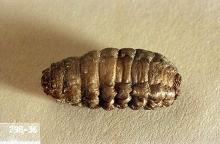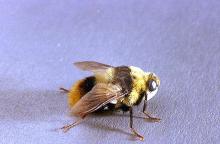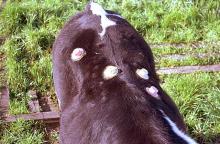Common cattle grub (heel fly) (Hypoderma lineatum)
Northern cattle grub (Hypoderma bovis)
Biology Typically, the life cycle of a cattle grub spans about a year, with much of that time spent as a larva developing inside the animal's body (forming a cyst/warble in the later stages). To avoid adverse host-parasite reactions, cattle should be treated either before or after grubs migrate through the body. The best time to treat would be as soon as the heel fly (adult stage) season is over (and before the larva migrates inside the body). In practical terms, treatment for grubs may be accomplished at the same time as fall treatment for internal parasites but no later than November 30 to prevent a toxic reaction from dead/dying grubs that have migrated to vital regions such as the esophagus or spinal canal.
Adults have a bee-like appearance and range from 11 to 18 mm in length. Females will lay eggs on hairs. Larvae emerge from eggs in four to six days and crawl down hairs to burrow into skin of the cattle. Larvae will spend considerable time migrating to the back of the animal in order to create a breather hole that develops into a cyst that is called a warble. During warble stages the cattle struggle to eat properly, seeking water and shaded areas to avoid flies.
Management-chemical control
- eprinomectin pour-on (Eprinex)-Apply at 1 ml/10 kg (22 lb) body weight. Apply along midline of back.



